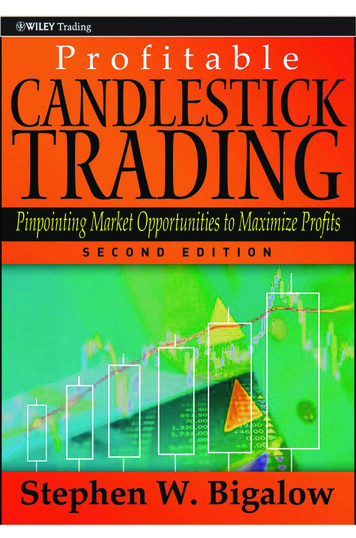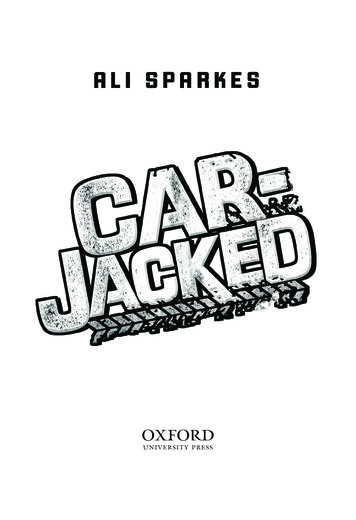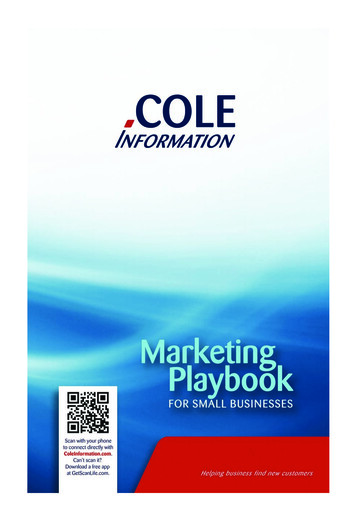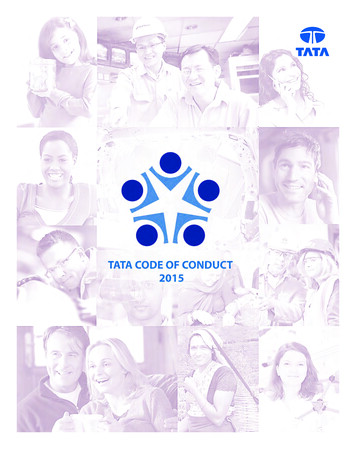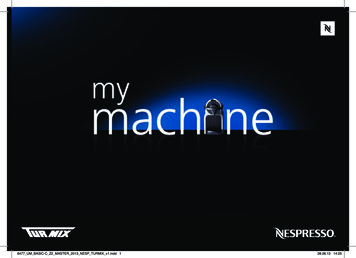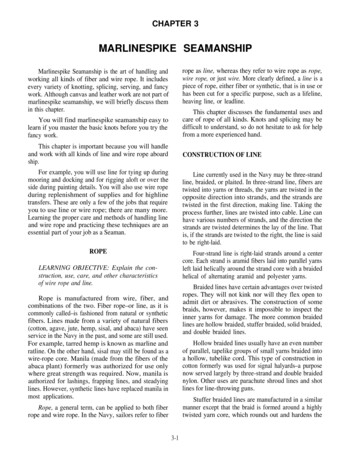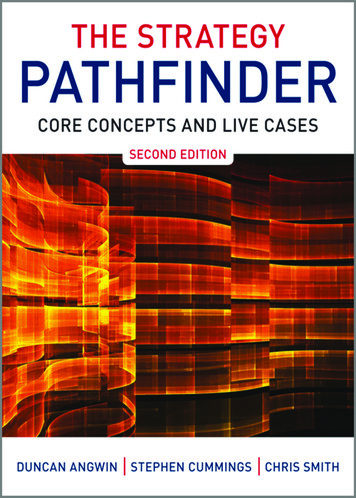
Transcription
ffirs.indd ii1/7/11 6:50:32 AM
THE STRATEGYPATHFINDER2nd edition
Further praise for The Strategy Pathfinder“Do we really need another book on strategy? Well The Strategy Pathfinder is onewith an attitude! Its effective use of an impressively broad range of micro-casesthat cover the main concepts of business strategy gives students a succinct andvery practical approach to the subject.”Peter Hagström, Stockholm School of Economics“The unique micro-cases in this book will surely spark energetic discussion inthe classroom. The diversity of international companies and strategic issues inthe cases provides an unusually broad set of examples from which to draw.”Constance E. Helfat, Dartmouth College“The Strategy Pathfinder represents a refreshing and engaging method for teachingstrategy. The processes and cases, which define the book, provide excellent learning materials that bring a real-life experience to students.”Stuart Sanderson, Bradford University“The concise presentation and critical reflection on strategy concepts and tools;the use of live cases; and the inclusion of rarely covered yet highly relevant topics,such as the role of power in strategic decision-making and the challenge of managing change, make The Strategy Pathfinder a welcome alternative to conventionalstrategy textbooks.”Stefan Manning, University of Massachusetts
THE STRATEGYPATHFINDER2nd editionCORE CONCEPTS AND LIVE CASESDUNCAN ANGWIN - STEPHEN CUMMINGS - CHRIS SMITHJohn Wiley & Sons, Inc.
This edition first published 2011 2011 Duncan Angwin, Stephen Cummings, Chris SmithRegistered officeJohn Wiley & Sons Ltd, The Atrium, Southern Gate, Chichester, West Sussex, PO19 8SQ,United KingdomFor details of our global editorial offices, for customer services and for information abouthow to apply for permission to reuse the copyright material in this book please see ourwebsite at www.wiley.com.The right of the author to be identified as the author of this work has been asserted inaccordance with the Copyright, Designs and Patents Act 1988.All rights reserved. No part of this publication may be reproduced, stored in aretrieval system, or transmitted, in any form or by any means, electronic, mechanical,photocopying, recording or otherwise, except as permitted by the UK Copyright, Designsand Patents Act 1988, without the prior permission of the publisher.Wiley also publishes its books in a variety of electronic formats. Some content that appearsin print may not be available in electronic books.Designations used by companies to distinguish their products are often claimed astrademarks. All brand names and product names used in this book are trade names,service marks, trademarks or registered trademarks of their respective owners. Thepublisher is not associated with any product or vendor mentioned in this book. Thispublication is designed to provide accurate and authoritative information in regard to thesubject matter covered. It is sold on the understanding that the publisher is not engagedin rendering professional services. If professional advice or other expert assistance isrequired, the services of a competent professional should be sought.Library of Congress Cataloging-in-Publication DataAngwin, Duncan, author.The Strategy Pathfinder : Core Concepts and Live Cases / Duncan Angwin, StephenCummings, Chris Smith. —2p. cmIncludes bibliographical references and index.ISBN 978-0-470-68946-2 (pbk.)1. Strategic planning. 2. Stragegic planning—Case studies. I. Cummings, Stephen David,1967-, author. II. Smith, Chris, author. III. Title.HD30.28.A5315 2011658.4'012—dc222010045351A catalogue record for this book is available from the British Library.ISBN 978-0-470-68946-2 (paperback), ISBN 978-1-119-99017-8 (ebk),ISBN 978-1-119-99588-3 (ebk), ISBN 978-1-119-99589-0 (ebk)Set in 10/12.5pt Book Antique by MPS Limited, a Macmillan Company, Chennai, IndiaPrinted in Great Britain by TJ International Ltd, Padstow, Cornwall, UK
ContentsContentsviixiiixxviThe Strategy Pathfinder MapPathways to StrategyAbout the Author’sPART I THE STRATEGIC ENVIRONMENT1.Macro-Shocks2.Movers and Shakers393.Industry Dynamics733PART II THE STRATEGIC ORGANIZATION4.Corporate Strategy1075.Strategic Positioning1396.Corporate Identity1737.Organic Strategy201PART III STRATEGIC ADVANCES8.Crossing Borders2319.Guiding Change267PART IV STRATEGIC FUTURES10.Sustain Ability30311.Maverick Strategies337v
ContentsIntegrative CasesUsing The Strategy Pathfinder 2nd Editionfor Assessments and ExaminationsPrimary Chapter and Case AuthorsNotesReferencesAcknowledgementsGlossary of Core Strategic Management ConceptsIndexvi371383389395409415417429
The Strategy Pathfinder MapThe Strategy PathfinderMapThe Strategy Pathfinder is arranged into 11 chapters or pathways, preceded by ashort introduction (or “instruction manual”). Each pathway focuses on a set of coreconcepts followed by seven “live cases” that readers can use to test their ability touse those concepts. A dashed line around a live case‘s title square indicates that itfocuses on a not-for-profit (NFP) organization. Each pathway/chapter contains atleast one NFP case, thereby creating an NFP track through The Strategy Pathfinderfor those who wish to focus on this path. In addition, readers may choose tofocus on a particular geographic area by consulting The Strategy Pathfinder WorldMap on page xi. Introduction: Pathways to StrategyStrategy matters What is strategy? Why The Strategy Pathfinder is a differentkind of strategy textbook How The Strategy Pathfinder worksPART I: THE STRATEGIC ENVIRONMENT1. Macro-ShocksOpen systems thinking bounded rationality Icarus paradox scanning/monitoring/forecasting/assessing scenario thinking PEST/ESTEMPLEanalysis impact matrix SWOT/TOWS analysis strategic hAfricaChinaAirways2. Movers and ShakersCorporate governance chain of ownership principles/agents role of theCEO and directors stakeholder analysis using management consultants government influences power/interest matrix lobbyingDisneySafewayCarlton TVLafargeviiBrasiliaNHSMGMT
The Strategy Pathfinder Map3. Industry DynamicsMargins perfect and imperfect competition industry life cycle criticalsuccess factors industry structure the five forces of industry the value net complementors and BMXRA Maroc IPART II: THE STRATEGIC ORGANIZATION4. Corporate StrategyThe M-form organization corporate strategy forms of diversification portfolio management growth-share (or BCG) matrix parenting advantage sharing activities transferring skills centralization versus RA Maroc II5. Strategic PositioningCompetitive advantage positioning cost advantage differentiationadvantage focus advantage generic strategy matrix strategy clock advantage categories game theory the value chain strategic groups resource-based view CASIS and VIRO IBBWorldCitiesInBev6. Corporate IdentityNational culture and context the Porter diamond organization culture McKinsey’s 7-S framework the cultural web corporate identity, image andpersonality authenticity vision, mission and viiiNZ PoliceBBC & C5
The Strategy Pathfinder Map7. Organic StrategyThe relational organization social systems knowledge societies and learningorganizations signature stories communities of practice social capital networks resources and dynamic capabilities emergence, process andpractice the balanced scorecardF1The BandWaMuDeutscheBankPrudentialAASDalai LamaPART III: STRATEGIC ADVANCES8. Crossing BordersInternationalization and globalization theories of absolute and comparative advantage expansion strategies M&A strategies divestment andretrenchment eclectic theory country clusters leveraging national advantage international business structuresKodakKorean AirVodafone/MannesmanCoca-cola/ToyotaBanque deSudRed Cross/CrescentHSBC9. Guiding ChangeIncreasing pace of change 8-steps of change different levels of change evolutionary versus revolutionary change different change needs styles ofmanaging change instigators of change resistance to change leadershipand strategic changePringleReliantBarakaChurchesOakland A’selBulliLittle ChefPART IV: STRATEGIC FUTURES10. Sustain AbilityThe firm and the wider environment sustainable development and sustainability environmental integrity corporate economic prosperity corporatesocial equity the triple bottom line reputation business ethics greenwashing versus the good corporate citizenMcDonaldsMonsantoHandiGhandiMarcosixIl NgwesiAir NewZealandRoyal Mail
The Strategy Pathfinder Map11. Maverick StrategiesBeyond “best practice” Blue Ocean strategy S-curves worst, good, promising and next practices diversity urgency entrepreneurial 1 financial flair design thinking stratography 6 degrees of strategic neCCCPAdditional Material: Integrative cases, Chapter and Case Authors, Notes,Using Strategy Pathfinder for Assessments and Exams, References,Glossary, Index x
Strategic AdvancesThe Strategic Organization9.3 BarakaNFP (not for profit) casesStrategic Futures1.6 MontFleur10.5 Il Ngwesi7.3 WashingtonMutual5.3 Mother’sPreference6.6 NZ Police10.6 Air New Zealand4.6 Telco11.2 IRL6.3 Mojo/MDA10.4 Handi Ghandi10.3 Marcos8.4 Coca Cola and 3.4 Dell8.1 Kodak Toyota4.1 Z8.6 Red 7.7 The Dalai9.5 Oakland A’s6.5 HyundaiCross Lama on the GFC6.1 Pokemon3.1 Sportswear8.2 Korean Air3.51.7 Chinese 4.3 Golden Promise5.5 IBBRanbaxyAirlines8.7 HSBC5.7 World cities4.5 Tata11.7 CCCP6.2 Pharmacia1.3 FloraHolland7.5 Deutsche Bank5.6 InBev5.2 Tele28.3 VodafoneMannesman3.2 Carrefour9.6 el Bulli7.1 F111.3 Synear8.53.7 Royal du SudAir Maroc I4.7 Royal AirMaroc II1.2 English/French armies2.4 LafargeThe Strategic Environment11.4 VentureCapital11.5 Egg10.7 Royal Mail9.7 Little Chef9.4 Churches9.2 Reliant9.1 Pringle7.4 Prudential7.2 The Band6.4 John Smith’sBitter6.7 Channel 51.5 Rover2.2 Safeway2.3 Carlton TV2.6 NHS4.4 Easy Group5.1 Tesco5.4 Taytos10.1 McDonalds II11.6Danone2.5 Brasilia1.1 Steinway4.2 GE3.6 X-Games2.1 Disney7.6 AAS3.3 McDonalds10.2Monsanto2.7 Mgmt gurus11.1 Apple/Ford1.4 Nike
Strategy Matters. . .Strategy matters in business:Steve Jobs’s brilliant strategy [for the Apple iPod business] was to marry the hardwaredevice with the web service with the desktop. And that kind of strategy is very difficult tocopy (which makes it even more strategic).“A Gallant attempt at making IT interesting. . .”Silicon Valley Watcher, Tom Foremski, August 18, 2005Strategy makes a difference in politics (and anyone involved in business knowsthat politics matters in business too). Good strategy helped Barrack Obama tobecome President of the United States. Here’s one journalist’s distillation ofObama’s keys to his strategic and political success in the 2008 campaign:1. Define your character. When you create a consistent character that embodies your deepest principles people perceive you as “whole” and trustworthy. We align with leaders whoare aligned with themselves. According to Joel Benenson, the primary pollster for the Obamacampaign, Obama’s image was more clearly defined than McCain’s. . . As a result people perceived Obama as a truth teller 2. Create a strong, positive and consistent message. Barack Obama had one elegant philosophical approach that was simple to assimilate and understand. “Voters are looking for theremedy not the replica.” His strategy was to position his opponent, John McCain, as thereplica and himself the remedy. . . Distilling your message into one clear sentence has deepresonance.3. Communicate casually via video. David Plouffe, one of Barack Obama’s campaign managers, created home-made-looking online videos discussing strategies to keep supporters andorganizers excited, engaged, and involved. . . These videos are similar to the ones friendsmight send to each other to stay connected on Facebook, YouTube or MySpace.“Barack Obama’s Campaign Strategy”Examiner.com, Susan Harrow, December 2, 2008Strategy also matters in the media and in public relations (which also plays a bigrole in business and politics these days):xiiiPathways to StrategyPathways to Strategy
Pathways to StrategyIt has long been the norm for Project Runway to film collections by the last threedesigners standing plus one decoy to avoid the seemingly inevitable leaks and spoilers -a challenge more daunting than ever now that everyone in the Fashion Week audiencehas some kind of instant communications device in hand throughout. But those of us whowere invited. . . to attend last week’s fashion show hit the jackpot, unexpectedly treated toa record ten collections on the runway – that would be collections by the final three (whoever they may be), the traditional decoy finalist and six additional possible contenders,all of them still in play on the show. . . Adding so many extra collections was a brilliantstrategy, seeing as it is seemingly impossible for the media to keep secrets in the newdigital world. . .“Inside the Season Finale of Lifetime’s Project Runway”HuffingtonPost.com, Ed Martin, February 17, 2010And strategy shapes results in football too (and many have compared the media,politics, and business to a game).I’ve looked at the Dutch strategy – it is invariably a strong middle field with a consistent 4-5-1 strategy. Spain regularly plays 4-4-2, more aggressive than the Dutch style.Spain is incredibly good on defense and on making things happen on the attack, justenough to take home a win. Holland also has an incredibly strong defense – does it havethe brilliance of 2010 Spain on the attack? Ah, this will be a thinking person’s World CupFinal, that’s for sur
analysis impact matrix SWOT/TOWS analysis strategic agility South Africa Steinway French Army Flora Holland Nike Rover China Airways Disney Safeway Carlton TV Lafarge Brasilia NHS MGMT 2.vers and Shakers Mo Corporate governance chain of ownership principles/agents role of the CEO and directors stakeholder analysis using management consultants government .
